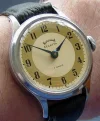- Joined
- Mar 16, 2002
- Messages
- 6,660
- Reaction score
- 578
In 1962, NASA decided to equip the astronauts of its future Gemini program with a highly accurate, legible, resistant and reliable wrist chronograph.
Donald K. Slayton, head of the flight Crew Operations , took action to select the chronographs :
For the purpose of comparison tests, NASA purchased chronographs different brands from Corrigan's, a large retailer in Houston, Texas the following watches where purchased : Elgin, Benrus, Hamilton, Mido, Piccard, Omega, Bulova, Rolex, Longine and Gruen. Of theses only 3 where selected for the comparative evaluation testing :
Longines, Omega and Rolex (Omega movement : Omega 321 , Rolex movement : Valjoux 72 , Longines : Longines 13 ZN)
1965 first qualification program :
Model tested : probably 105.012 no documents found for the moment to firmly state this , but for sure a Speedmaster equipped with Omega 321 calibre
High temperature: 48 hours at 71º C followed by 30 minutes at 93º C. This under a pressure of 0,35atm and relative humidity not over 15%.
Low temperature: Four hours at -18º C.
Temperature-pressure: 0,000001atm and temperature raised to 71º C. Temperature then lowered to -18º C in 45 minutes and again raised to 71º C in 45 minutes. This cycle was repeated fifteen times.
Relative humidity: 240 hours in relatuve humidity of at least 95% and at temperatures varying between 20º C and 71º C. The steam had a pH value of between 6,5 and 7,5.
Oxygen atmosphere: Exposure to 100% oxygen atmosphere at a pressure of 0,35atm and a temperature of 71º C for 48 hours.
Shock: Six 11 millisecond shocks of 40g each in six different directions.
Acceleration: Linear acceleration from 1g to 7,25g within 333 seconds.
Decompression: 90 minutes in a vaccum of 0 10-6 atm and a temperature of 71º C and 30 minutes in the same vaccum but at a temperature of 93ºC.
High pressure: Exposure to 1,6atm for one hour.
Vibration: Three cycles of 30 minutes (lateral, horizontal and vertical), the frequency varying from 5 to 2000cps and back to 5cps in 15 minutes. Average acceleration per impulse 8,8g.
Acoustic noise: 130dB over a frequency range from 40 to 10000Hz for 30 minutes
Results of the tests :
Omega Speedmaster : gained 21 minutes during decompression test and lost 15 minutes during the acceleration test , the luminescence of the dial was lost during the test
Rolex Daytona : stopped running on two occasions during the relative humidity test and during the high pressure test when the sweep second hand warped and press against the other hands
Longine Wittnauer : Crystal warped and disengaged during the high pressure test , same fault occurred during the decompression test
Final conclusion : the Omega chronograph performed satisfactorily
In 1965, NASA chose the Omega Speedmaster Professional as the official chronograph for the space program.
With the first Gemini flight (GT3) with astronauts Grissom and Young, the Speedmaster Professional became part of the standard equipment issued to the astronauts. The watch was worn on the outside of the pressure suit with the use of a large black velcro band.
The Speedmaster was worn during the first walk in space by an American, Edward White, in 1965. Two Speedmaster were worn by each Gemini astronaut one set on mission time , the other one on GMT or Houston time.
1967 : Apollo Program
Due to its performance, reliability and success with the Gemini program the Speedmaster Professional was selected again as the official chronograph by NASA for project Apollo.
Each astronaut wore one chronograph for spaceflight as a standard issue. Most, however, wore two during spaceflight. Some astronauts have used other watches as backup only one Speedmaster was issued to the astronauts.
The First watch worn on the moon ?
As the official chronograph for all Apollo missions, the Speedmaster Professional was worn by Frank Borman and crew on man's first journey to orbit the moon during Christmas of 1968
Anybody might think that the first watch on the moon was worn by Neil Armstrong ... but ...he did not wear his Speedmaster on his walk on the moon. An instrument had malfunctioned during the LEM's Decent and his Speedmaster was left in the LEM to serve as a replacement :
"our mission timer was out, and we decided we had better leave one wristwatch inside in case it (the one taken outside) got damaged. We would have at least one working watch to back up the mission timer or to use in place of the mission timer, in case we could not get it going again" Armstrong, from the 1969 Technical Debrief
Therefore the very first watch to be worn on the moon was Aldrin's Speedmaster
To be continued.................
Donald K. Slayton, head of the flight Crew Operations , took action to select the chronographs :
For the purpose of comparison tests, NASA purchased chronographs different brands from Corrigan's, a large retailer in Houston, Texas the following watches where purchased : Elgin, Benrus, Hamilton, Mido, Piccard, Omega, Bulova, Rolex, Longine and Gruen. Of theses only 3 where selected for the comparative evaluation testing :
Longines, Omega and Rolex (Omega movement : Omega 321 , Rolex movement : Valjoux 72 , Longines : Longines 13 ZN)
1965 first qualification program :
Model tested : probably 105.012 no documents found for the moment to firmly state this , but for sure a Speedmaster equipped with Omega 321 calibre
High temperature: 48 hours at 71º C followed by 30 minutes at 93º C. This under a pressure of 0,35atm and relative humidity not over 15%.
Low temperature: Four hours at -18º C.
Temperature-pressure: 0,000001atm and temperature raised to 71º C. Temperature then lowered to -18º C in 45 minutes and again raised to 71º C in 45 minutes. This cycle was repeated fifteen times.
Relative humidity: 240 hours in relatuve humidity of at least 95% and at temperatures varying between 20º C and 71º C. The steam had a pH value of between 6,5 and 7,5.
Oxygen atmosphere: Exposure to 100% oxygen atmosphere at a pressure of 0,35atm and a temperature of 71º C for 48 hours.
Shock: Six 11 millisecond shocks of 40g each in six different directions.
Acceleration: Linear acceleration from 1g to 7,25g within 333 seconds.
Decompression: 90 minutes in a vaccum of 0 10-6 atm and a temperature of 71º C and 30 minutes in the same vaccum but at a temperature of 93ºC.
High pressure: Exposure to 1,6atm for one hour.
Vibration: Three cycles of 30 minutes (lateral, horizontal and vertical), the frequency varying from 5 to 2000cps and back to 5cps in 15 minutes. Average acceleration per impulse 8,8g.
Acoustic noise: 130dB over a frequency range from 40 to 10000Hz for 30 minutes
Results of the tests :
Omega Speedmaster : gained 21 minutes during decompression test and lost 15 minutes during the acceleration test , the luminescence of the dial was lost during the test
Rolex Daytona : stopped running on two occasions during the relative humidity test and during the high pressure test when the sweep second hand warped and press against the other hands
Longine Wittnauer : Crystal warped and disengaged during the high pressure test , same fault occurred during the decompression test
Final conclusion : the Omega chronograph performed satisfactorily
In 1965, NASA chose the Omega Speedmaster Professional as the official chronograph for the space program.
With the first Gemini flight (GT3) with astronauts Grissom and Young, the Speedmaster Professional became part of the standard equipment issued to the astronauts. The watch was worn on the outside of the pressure suit with the use of a large black velcro band.
The Speedmaster was worn during the first walk in space by an American, Edward White, in 1965. Two Speedmaster were worn by each Gemini astronaut one set on mission time , the other one on GMT or Houston time.
1967 : Apollo Program
Due to its performance, reliability and success with the Gemini program the Speedmaster Professional was selected again as the official chronograph by NASA for project Apollo.
Each astronaut wore one chronograph for spaceflight as a standard issue. Most, however, wore two during spaceflight. Some astronauts have used other watches as backup only one Speedmaster was issued to the astronauts.
The First watch worn on the moon ?
As the official chronograph for all Apollo missions, the Speedmaster Professional was worn by Frank Borman and crew on man's first journey to orbit the moon during Christmas of 1968
Anybody might think that the first watch on the moon was worn by Neil Armstrong ... but ...he did not wear his Speedmaster on his walk on the moon. An instrument had malfunctioned during the LEM's Decent and his Speedmaster was left in the LEM to serve as a replacement :
"our mission timer was out, and we decided we had better leave one wristwatch inside in case it (the one taken outside) got damaged. We would have at least one working watch to back up the mission timer or to use in place of the mission timer, in case we could not get it going again" Armstrong, from the 1969 Technical Debrief
Therefore the very first watch to be worn on the moon was Aldrin's Speedmaster
To be continued.................

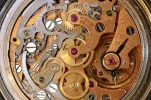
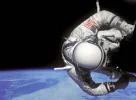
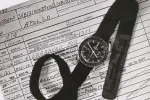
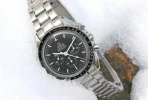

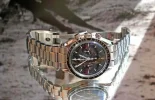



 I have to be difficult though, and ask when did digital watches come about (80's?) - they'd work ok up there I guess?
I have to be difficult though, and ask when did digital watches come about (80's?) - they'd work ok up there I guess? 
